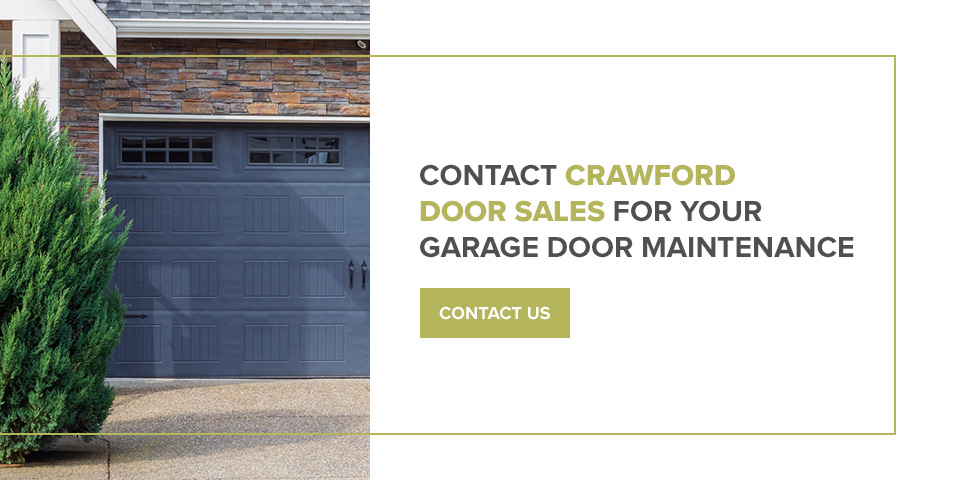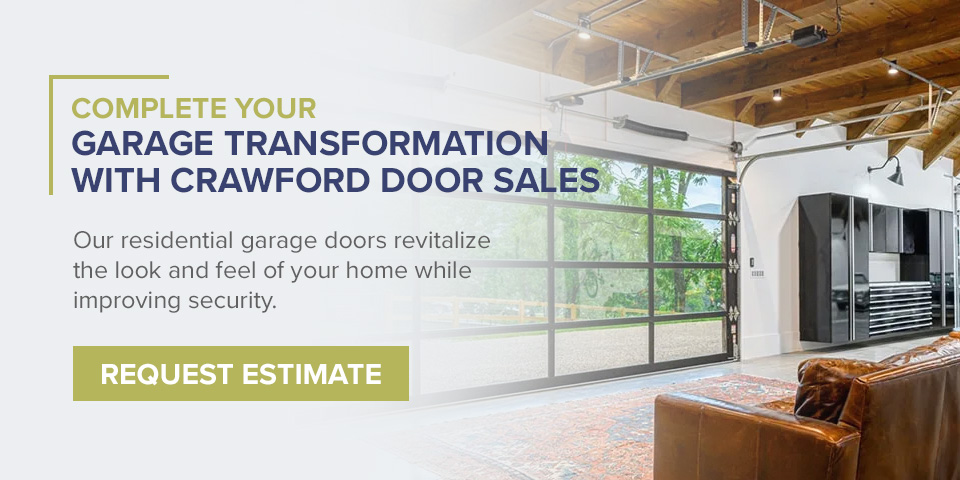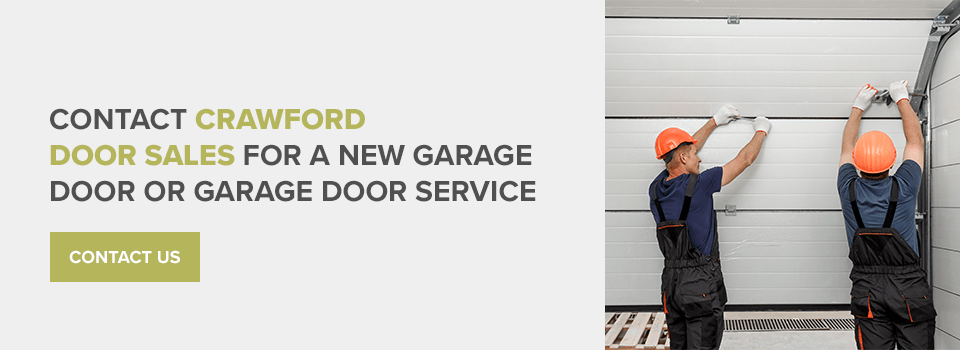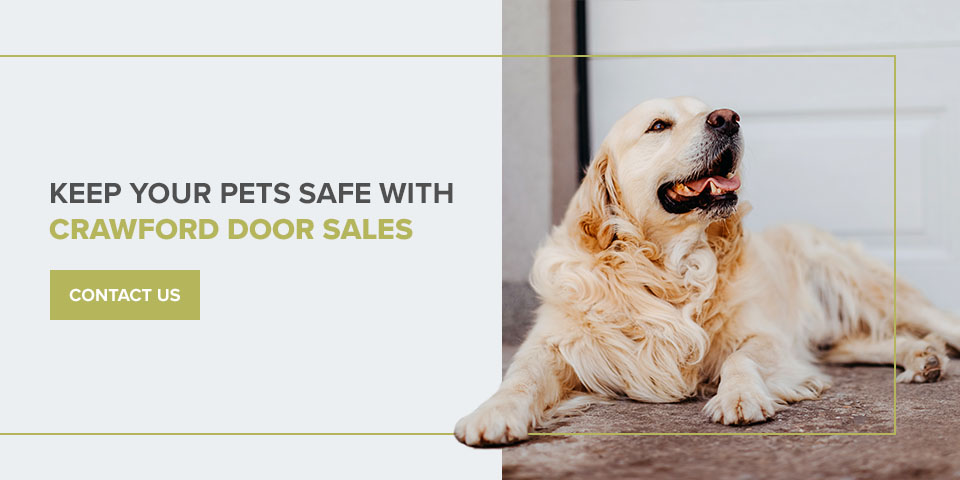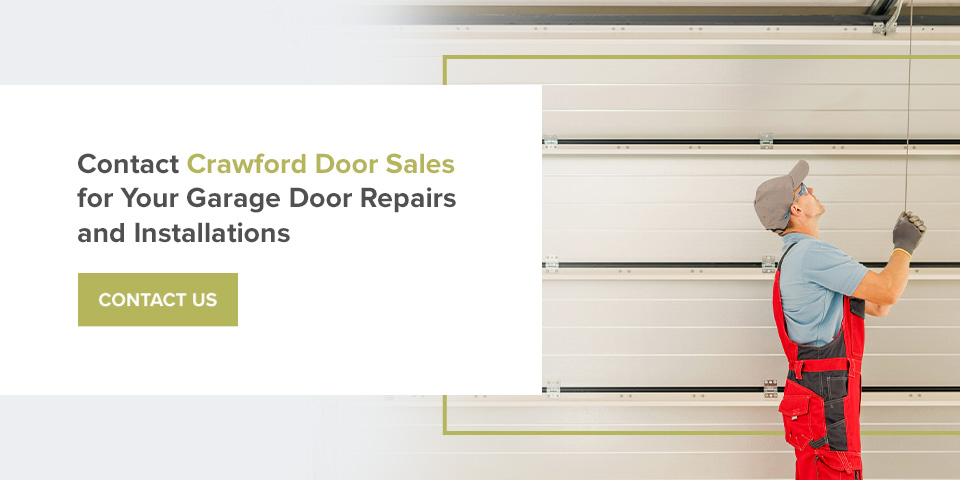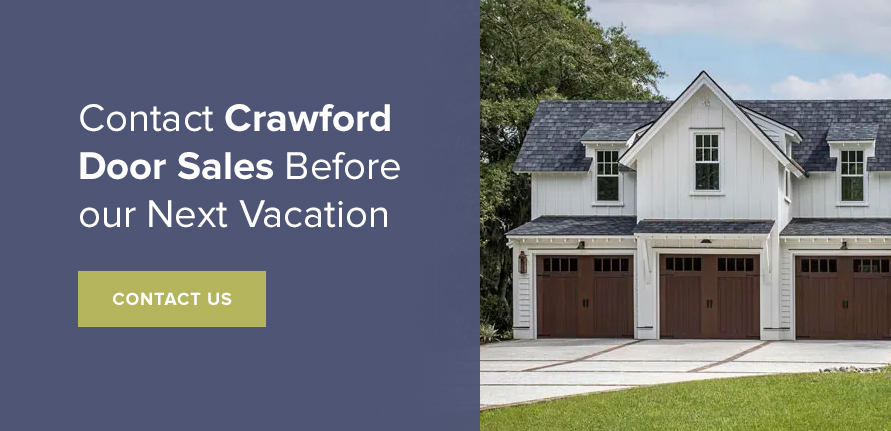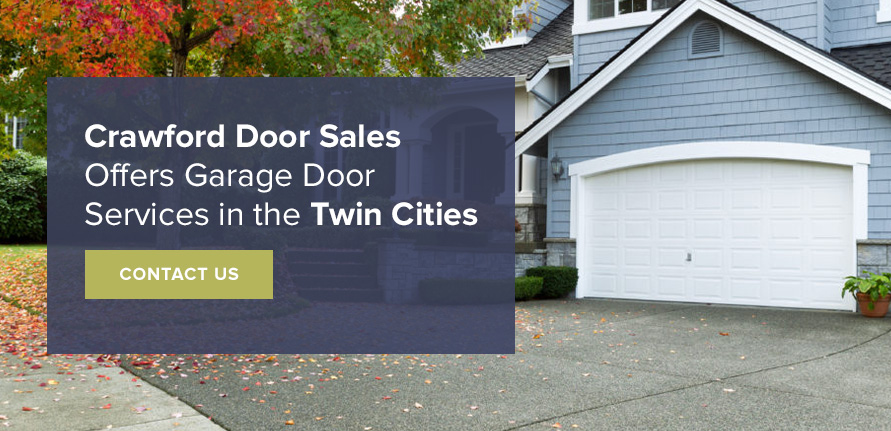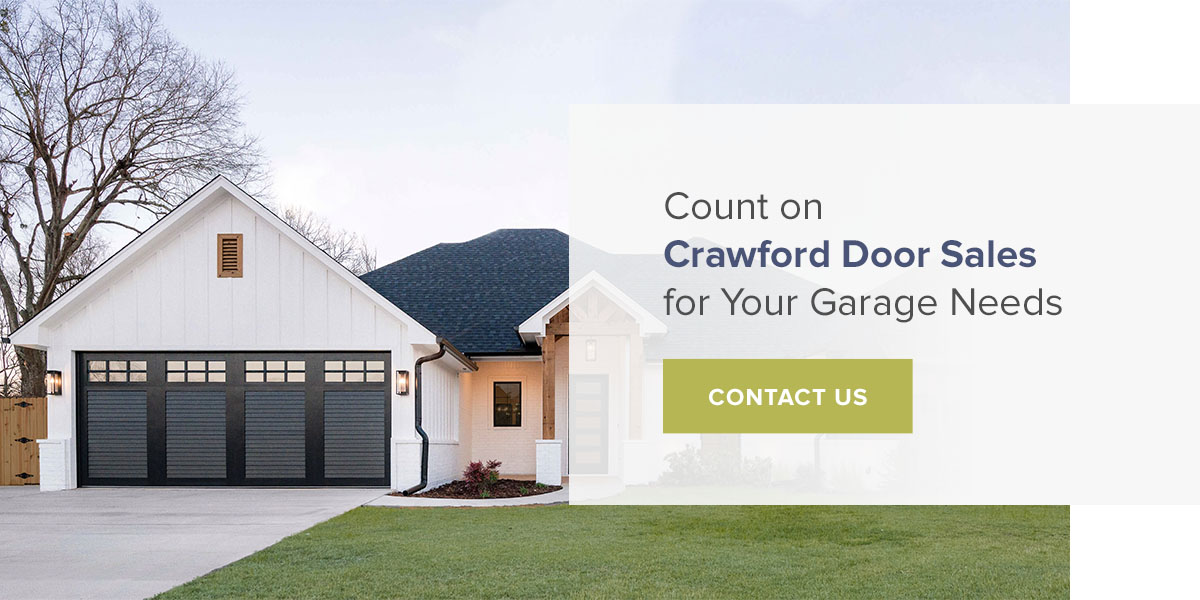How the Right Garage Door Can Reduce Your Monthly Energy Bills
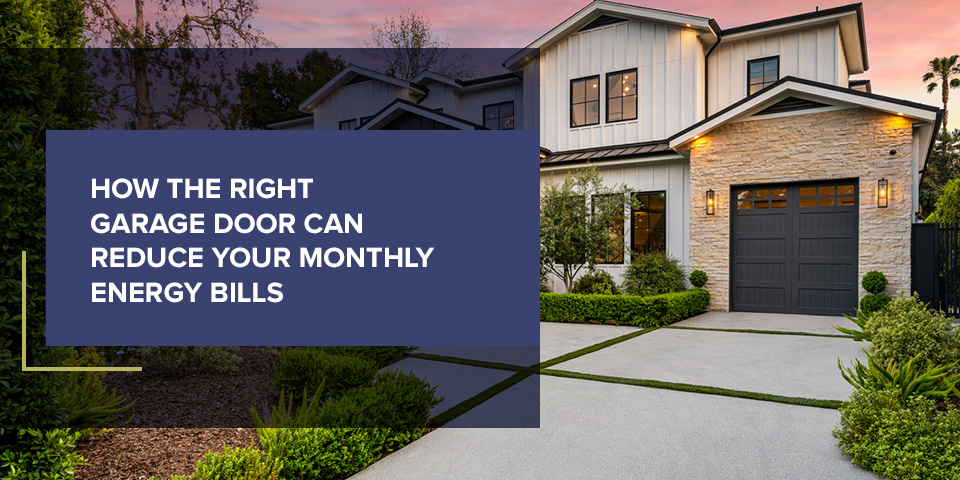
If you’re looking for ways to improve your home’s energy efficiency, consider starting with your garage door — it’s a key area for potential savings. As one of the largest openings in your home, your garage door can significantly impact your overall energy use, especially if your garage is attached to your living space.
A properly insulated and sealed garage door is a barrier against outside temperatures, helping maintain consistent indoor conditions and easing the load on your HVAC system. That means less energy use and lower monthly bills. Whether you’re building a new home or upgrading an existing garage, choosing the right door can deliver energy savings and comfort for the near future.
Understanding Garage Door Insulation and R-Value
When evaluating garage doors for energy efficiency, R-value is one of the most important elements to consider. This number measures the door’s ability to resist heat flow. The higher the R-value, the better the insulation. A higher R-value means your garage is better equipped to keep warm air in during the winter and out during the summer. The Department of Energy provides detailed information on R-value and insulation standards.
Types of Insulation Materials
There are two common types of insulation used in garage doors:
- Polystyrene: This rigid foam insulation, also known as Styrofoam, is often inserted between the layers of a garage door. While cost-effective and lightweight, polystyrene generally offers lower R-values compared to polyurethane.
- Polyurethane: This high-performance insulation is injected between the layers of the garage door, expanding to fill the entire cavity. It offers superior thermal resistance and structural strength, making it an energy-efficient choice.
Insulated vs. Uninsulated Garage Doors
An uninsulated garage door offers little to no resistance to temperature fluctuations, essentially turning your garage into a giant heat sink. During winter, it can allow cold air to seep in, making adjacent rooms colder and increasing your heating bills. In the summer, heat from the garage can radiate into your home, forcing your air conditioner to work harder.
In contrast, an insulated garage door creates a thermal barrier that helps stabilize indoor temperatures. This barrier is particularly beneficial for attached garages or those used as workshops, home gyms or laundry rooms.
Many homeowners wonder if they really need an insulated garage door. Upgrading to an insulated garage door can significantly improve your home’s energy efficiency and comfort, even enough to notice a difference in your monthly utility bills.
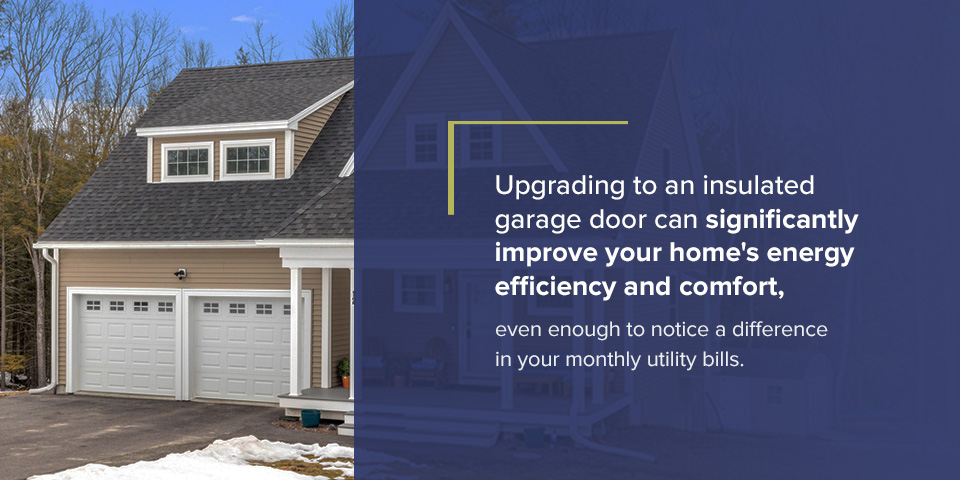
Features and Benefits of Energy-Efficient Garage Doors
When shopping for an energy-efficient garage door, it’s important to understand what to look for. Modern doors offer a range of features specifically designed to minimize energy loss and withstand seasonal temperature changes. Here are a few key features to consider:
- Insulation type and thickness: Look for doors with polyurethane insulation and a high R-value, such as R-12 to R-18 for residential use. Thicker insulation improves performance and durability.
- Multilayer construction: Energy-efficient doors typically have two or three layers made from steel or aluminum outer layers with an insulated core. This design improves thermal performance while enhancing noise reduction and structural integrity.
- Weather stripping and bottom seals: High-quality garage doors include flexible weather seals around the frame and along the bottom edge. These components block air drafts, moisture, dust and pests from entering your garage.
- Thermal breaks: Some advanced models include thermal breaks, which are nonconductive materials between layers, to prevent heat or cold from transferring through the door’s structure.
These elements reduce heat transfer and air leakage, two major contributors to energy loss. When your garage door helps keep outdoor temperatures at bay, your home’s heating and cooling system has less stress. That translates to fewer energy spikes, less wear on your HVAC equipment and lower monthly bills.
Practical Tips on How to Save Energy in the Garage
While choosing an energy-efficient garage door is a smart move, pairing it with energy-conscious habits and upkeep can further boost your savings. Here are some practical tips every homeowner can follow.
1. Maintain Weather Seals
Check the seals around your garage door regularly for signs of wear, cracking or gaps. Damaged seals allow drafts and moisture to enter the garage, undoing the benefits of your insulated door. Replacing worn seals is a low-cost fix that can pay off in better insulation.
2. Use Your Door Responsibly
Leaving the garage door open, especially in extreme weather, lets conditioned air escape and invites outdoor air in. Try to limit the amount of time your garage door stays open to maintain interior temperature stability.
3. Insulate the Garage Walls and Ceiling
An energy-efficient garage door works best when it’s part of a broader insulation strategy. Insulating your garage walls and ceiling can help trap heat and make the space more comfortable year-round. This extra insulation is especially important if your garage shares a wall with a frequently used room.
4. Upgrade Your Garage Lighting
Swap out old incandescent bulbs with LED lighting, which uses significantly less electricity and generates less heat. This small switch can reduce your overall energy consumption and lower utility costs.
How Can You Make Your Garage Door More Energy-Efficient?
Replacing a whole garage door can put strain on your budget. Here are a few retrofit options that can help improve energy performance on your current setup. These upgrades are a budget-friendly way to reduce energy loss, especially if your current door is in good shape. Over time, these small improvements can lead to meaningful energy savings.
1. Add an Insulation Kit
Garage door insulation kits are available for most standard doors and typically use either polystyrene or reflective foil. While factory-insulated models are more effective, this option still significantly improves temperature regulation.
2. Replace Weather Stripping
Installing new perimeter weather stripping and a bottom door seal can close off air leaks and improve insulation. This is an affordable DIY project that delivers immediate results.
3. Install a Threshold Seal
When installed on the garage floor, threshold seals block drafts, rain and insects, particularly in older homes with uneven floors.
Discover Your Energy Savings
An energy-efficient garage door is more than just a smart home upgrade — it’s a practical investment in your home’s comfort and your long-term energy savings. From high R-values and multilayer insulation to tight weather seals and thermal barriers, today’s garage doors are engineered for performance.
Ready to experience the benefits of an energy-efficient garage door? Our experienced technicians are ready to help! Contact Crawford Door Sales today for a free consultation and quote. You can also call us at 651-455-1221 or visit us to talk to one of our garage door experts.
How to Convert Your Garage Into a Workspace

Whether you work from home or start a side hustle, converting your garage into an office or workspace maximizes your home’s functionality. If your garage has become a place of clutter instead of a safe home for your car, a conversion could be the best option.
How to Convert Your Garage Into an Office
An office in your garage is highly beneficial if you work from home or run a business. You’ll have fewer distractions and a dedicated area to work without the commute. Depending on how you convert your garage into an office, you may increase the value of your home. However, it’s more complex than simply moving your desk and computer into the space. You need a comfortable, safe spot to work. Take the following steps:
1. Learn About Zoning Laws, Building Codes and Permits
Your choice of garage office depends on several factors, including zoning laws, which dictate how you use specific land. Confirm that you can convert your garage into a home office before investing money. Your next step is to look at the relevant building codes, which outline health and safety standards for any renovation. You may also need a permit to convert your garage into a room. Find out how to obtain electrical, building and plumbing permits.
2. Insulate Your Space
Most garages lack the insulation you need to stay comfortable while working. Proper insulation can reduce your home’s energy usage if you use your garage for long periods during the day. Insulation also reduces noise from outside, which can help you focus. Ensure you insulate your garage door when you work on the garage itself, or your investment in insulation will lack value.
3. Update the Flooring
If you’re spending hours in your converted garage, it should be as comfortable as possible. Garages weren’t designed for office use, so their flooring is often plain, cold concrete. Adding new flooring transforms the look and feel of your room, keeping you comfortable regardless of the weather. Many companies make floor coatings specifically for garage conversions. Add rugs and other temporary solutions to match your office aesthetic.
4. Think About Wi-Fi
We often take for granted that the home Wi-Fi will reach the garage. In reality, your router might be too far from the garage or the walls too thick to get a decent signal. Before you move into your new office, check whether the Wi-Fi works properly. If not, you can purchase a Wi-Fi extender or move the router to get the necessary connectivity.
5. Invest in Good Lighting
Good lighting in your workplace is essential for reducing eyestrain and improving productivity. You can install energy-efficient lamps and hanging lights to create an office feel. You can also choose a garage door with windows to help your home office feel brighter during the day.
6. Tackle the Heating, Plumbing and Electrics
You want to be comfortable in your new office year-round, which could mean adding heating. You’ll also need electric connections and plumbing. Professionals can help you expand your central heating system, and you could add gas heaters if it makes more sense. Planning for all your technological needs is also essential. You’ll need many electrical points to power your PC, phone and lamps. Make provisions for hot and cold water if you install a sink, toilet or shower.
7. Create an Office Layout
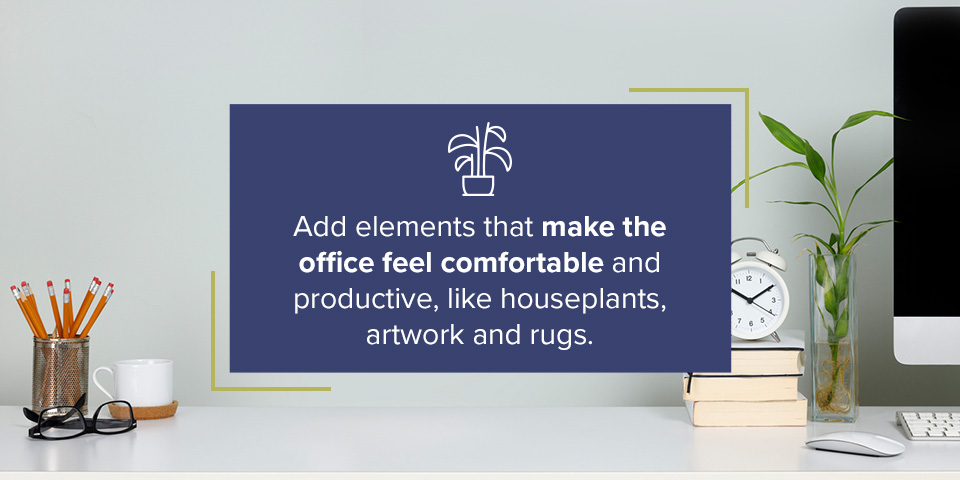
Once you have all the basics, think about how you want your office to look. Consider where to put your desk, chair and storage. Then, add elements that make the office feel comfortable and productive, like houseplants, artwork and rugs. Also, repaint the walls to bring the room together. You can also choose a garage door to complete the space and offer the insulation you need.
5 Other Garage Renovation Ideas
An office is just one of many uses for your garage. With the right approach, you can convert yours into any room that suits your needs. Here are some ideas to inspire you:
Home Gym
If you’re one of the 52% of adults who say they exercise regularly at home, a home gym could be ideal. An average garage typically has enough space for cardio machines, a bench, a bar and a squat rack — all the basics you need to get a good workout. One of the best things about transforming your garage into a gym is that you can start small and add more space and equipment as you improve your strength and fitness.
Playroom
Transforming the garage into a safe space for kids to play gives many parents peace of mind. It also keeps the toys out of sight, eliminating some of the clutter that comes with parenthood. Adults will also enjoy a playroom conversion. Instead of toys, you could add some gaming equipment, a bar or a pool table.
Hobby Room
Whether you like to craft or have a side hustle that brings out your creative side, it might be time for a dedicated room. You can transform your space into a storage area for your equipment and include a table and chair for working on your projects. If your garage is big enough, you can create a hobby section in your home office and keep all your projects in one place.
Home Theater
If you and your family love a good movie, your garage is the ideal space for a theater. Many garages have large, blank walls, which is the perfect location for a projector screen. Add some seating and electricity, and you have a DIY movie room. You can add to the design over time, bringing in a table for snacks, a popcorn machine and other fun items that enrich the experience.
Split Room
Your garage can also serve multiple purposes. For example, if you need a home office and a gym, you can use drywall or partitions to split it in half and accommodate both. Some split-room garage transformation ideas include:
- Office and gaming room
- Gym and theater
- Kids playroom and adult playroom
Complete Your Garage Transformation With Crawford Door Sales of the Twin Cities
Whatever you decide to do with your garage, one thing remains constant. You need a reliable, functional and aesthetically pleasing garage door. Since 1958, Crawford Door Sales Company has been providing exactly that. Our residential garage doors revitalize the look and feel of your home while improving security and maximizing performance.
We’ll help you choose a garage door based on vision. Once you’ve chosen one, our skilled and experienced technicians will install it for you. With us, you can transform your garage into a home office, gym or other room. Request an estimate and start the process today!
What Is the Average Lifespan of a Garage Door?
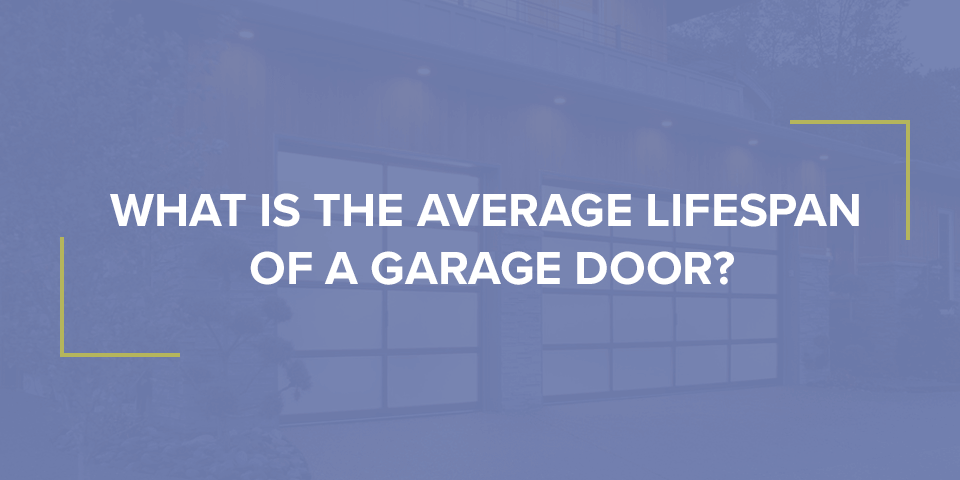
What Is the Average Lifespan of a Garage Door?
Every central feature of your home has an average lifespan before you’ll have to replace it. Elements like your roof, water heater, heating and air unit, electrical panel and garage door have lifetimes you can prolong by getting regular maintenance and choosing high-quality products.
Your garage door is a standout feature of your home. It impacts your curb appeal and might be the primary entry point. A quality garage door will operate properly, provide security and last a long time.
Knowing your garage door’s lifespan will help you determine when it needs upkeep and replacement. It’s also helpful when you’re building a new home and need to select a quality garage door that will last for several years.
Typical Lifespan of a Garage Door
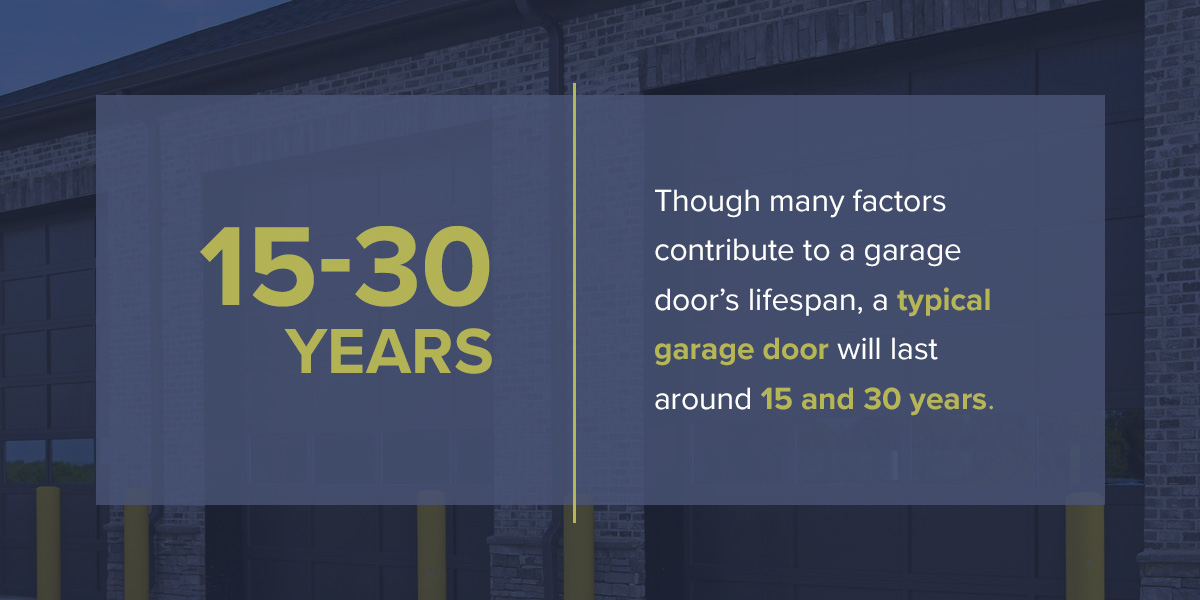
Though many factors contribute to a garage door’s lifespan, a typical garage door will last around 15 and 30 years.
Your garage door’s lifetime will vary depending on the type and brand you choose. Factors like the weather, environment, usage and maintenance schedule also impact the longevity of your garage door.
Take a look at how these factors can contribute to your garage door’s lifespan.
- Weather and environment: Depending on your location and the weather that usually occurs there, your garage door may experience damages related to storms, floods and other environmental factors.
- Usage: The amount of open-and-close cycles your garage door has depends on the type of springs it has. The more you use your garage door, the closer it will get to the end of its lifespan.
- Maintenance: If you regularly perform maintenance on your garage door, you’ll likely increase its lifespan.
- Door type: Purchasing your garage door from a trusted company and ensuring that you buy a high-quality door will boost the lifespan.
Your garage door is an essential part of your home, and it’s beneficial to inspect your door and all its components to avoid any garage door problems and ensure it’s working correctly and lasting as long as it should.
Learn About Our Garage Door Repair Services
Ways to Increase Your Garage Door’s Life Expectancy
While you can’t pinpoint the exact date you’ll need to replace your garage door, you can at least take extra steps to ensure you’re taking care of it and that it will last you a long time.
Instead of constantly repairing a broken garage door and racking up a service bill, try following some of these tips to prolong the lifespan of your garage door.
Replace Door Parts and Use Garage Door Lubricant
You should regularly inspect all parts of your garage door to ensure they’re working correctly or determine if you need to replace them. Your garage door has several components to inspect. It’s helpful to check features like rollers and weather seals because they’re typically cheaper replacement parts to purchase. If you catch these issues and fix them before they break, you can save yourself from making a service call.
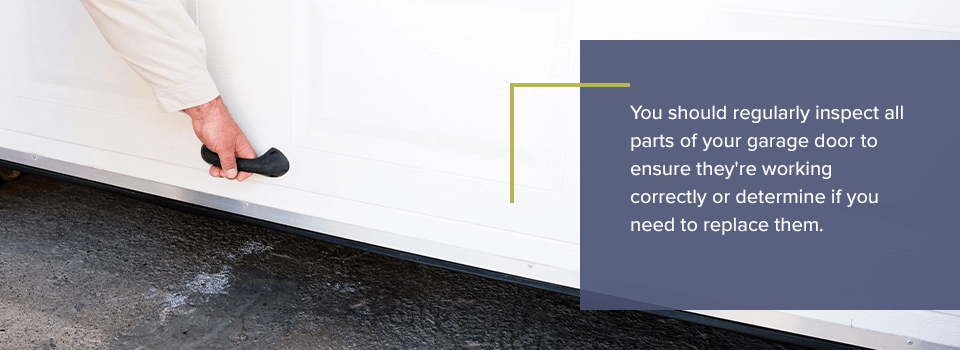
Some of the more expensive parts are your garage door opener, the panel and the springs. When it’s time to replace these parts, it’s worth buying quality replacement parts to increase the life of your garage door.
Monitor the Garage Door’s Function
The most crucial aspect of your garage door is performance. Many households use their garage door more often than their front door to enter the home, so it’s essential to check to make sure it’s working correctly and see if you need to perform maintenance or replace the door.
Whenever you open or close the garage door, look out for any noticeable changes in its performance. Even if a change doesn’t seem significant, it might be a sign of a more pressing concern in the future.
Look out for changes like:
- The door opening unevenly
- Unfamiliar sounds from the door opening and closing or the motor
- The door is moving at an irregular speed
Once you notice something off, you should contact your trusted garage door company for maintenance.
Understand Your Garage Door’s Warranty
Look over the warranty coverage for your garage door. It will likely have information that clues you in on the door’s expected lifespan. Along with reading your garage door’s warranty, it’s helpful to know when it ends so you can keep up with the maintenance after the warranty period is over.
Learn About Our Garage Door Repair Services
Monitor the Spring Function
By design, the springs in your garage door function for a specific amount of open-and-close cycles before you need to replace them. Research the type of springs your garage door system has to see their cycle amount. Doing so will help you gauge your springs’ replacement timeline and when to start monitoring them in case their performance starts to slow down.
If it’s time to replace your springs, contact your local garage door company to request a service technician.
Take Care of the Exterior
Cleaning your garage door’s exterior is a simple chore to add to your to-do list. Most garage doors will need a rag or mop and some mild cleaning detergent to achieve a like-new sparkle.
Caring for your garage door also depends on the type of door you own. Common residential garage door materials are wood, vinyl, aluminum or steel.
If you have a wooden garage door, check for cracks or warping of the wood panels. You may also need to repaint your wooden door if it begins to peel or look dull.
Homeowners with vinyl and aluminum doors should look for cracks or bends in the panels. The severity of the damage may require you to replace the panels or the door.
Steel garage doors may require care like sanding, painting and checking for rust on the exterior panels.
Call a Trusted Garage Door Company for Service
One of the most crucial things you can do to improve your garage door’s lifespan is to use a garage door company with years of experience and knowledge to service your garage door. A professional technician can give your advice on garage door care and perform quality maintenance that will impact the longevity of your garage door.
Lifespan of a Garage Door Opener
Your garage door opener is a crucial aspect of your door system, but it’s important to know that openers tend to have a shorter lifespan than the door itself. Most need replacing every 10-15 years. Still, there are a few things you can do to extend the lifespan of your garage door opener.
Keep up With Door Maintenance
Your garage door opener interacts with the garage door every time you use it, so it makes sense that the health of one is tied to the health of the other. By scheduling consistent maintenance and evaluations, you’ll ensure your opener isn’t straining or working harder than it has to to get your door opened or closed. This enhances your garage door opener’s lifespan and makes sure you get the full amount of years your opener is rated for.
Look for Signs of Wear
Sometimes, a garage door or garage door opener stops working out of the blue, but in most cases, there are signs preceding a complete breakdown. Every time you use your garage door, you should be looking for these indications that it’s time to call in a professional:
- The door starts to make more noise upon opening and closing: When you operate your garage door, some noise is expected. A sudden increase in noise or a sound you’ve never noticed before may indicate your garage door or garage door opener is reaching the end of its lifespan.
- The door takes more time to operate: You probably don’t time your door’s opening and closing, but when it starts to take longer than the few seconds you’ve come to expect, it can throw off your entire day.
- The door is unreliable: Is your door not closing the whole way, pausing in the middle of a cycle or stuck in one position? These are surefire signs it’s time for you to connect with Crawford Door Sales.
Get Garage Door Opener Maintenance
The best way to improve the lifespan of a garage door and its opener is to ensure both of them have regular maintenance. We discussed the need for door maintenance above, but the same is true for the opener itself. Your door relies on the intricate processes going on inside the opener, and even one misfire can throw the entire system off track. A good garage door professional will be able to evaluate both parts at once and determine which aspects are causing your issues.
Contact Crawford Door Sales for a New Garage Door or Garage Door Service
Your garage door is a vital part of your home, and knowing that it’s going to work every time you use it is the peace of mind every homeowner deserves. Contact Crawford Door Sales to perform high-quality maintenance on your garage door or shop for your new residential garage door.
How to Keep Your Pet Safe Around Garage Doors
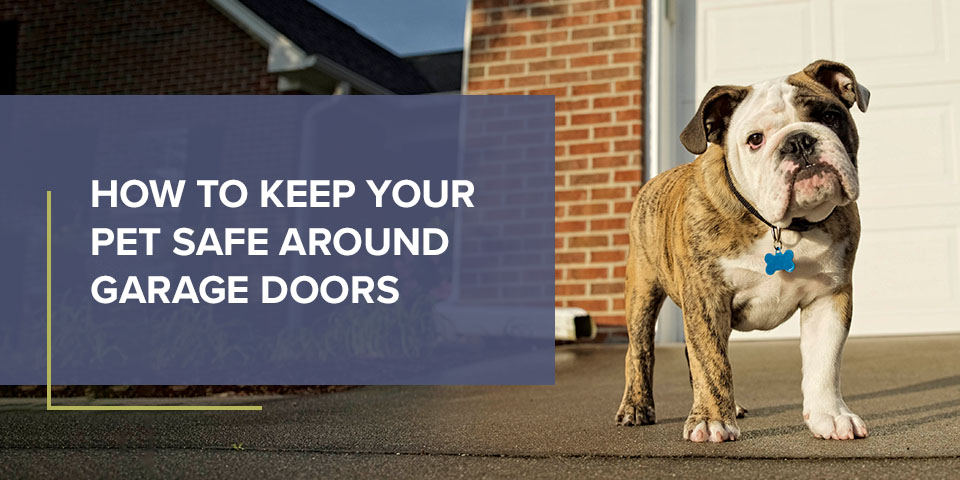
As a pet parent, you do everything to keep your pets safe. You keep them away from dangerous foods and protect them from safety hazards. If your pets make frequent trips to your garage, you may worry about their safety around the garage door. Keep reading to learn more about the importance of garage door safety around pets and how you can keep your cats and dogs safe.
Importance of Garage Door Safety Around Pets
Garage doors are designed to be safe for humans and animals alike. Automatic garage doors will stop closing when the sensors detect movement, which prevents the door from fully closing. The only way to get the door to start closing or opening again is to use the remote a second time. Despite how truly effective the garage door safety features are, you should be aware of the potential risks your garage door may pose.
Here are some common questions pet owners ask in regards to their garage door and pet safety:
Can a Garage Door Hurt a Cat?
This answer may come as a surprise, but other doors actually pose a greater risk to your cat than an automatic garage door. When a cat is injured by a shutting door, the cause is nearly always user error. You routinely open and close the front and back doors of your house so many times each day that it’s muscle memory. Sometimes, you’re tired and lost in thought, and your cat might linger in the threshold for a little too long.
An automatic garage door will react when something enters its sensors by immediately raising it back up. Cats run low to the ground and have a small surface area, giving them plenty of leeway to slip past a nearly shut garage door without being hurt.
Learn About Our Garage Door Repair Services
Can a Garage Door Kill a Cat?
Feline fatalities from garage door accidents are exceptionally rare, even for pets that spend a lot of time lounging around garages and mudrooms. Since garage doors have motion sensors that can detect movement, it’s unlikely that a garage door would kill a cat. While accidents do happen, following pet safety tips can keep your furry friends safe.
How Do I Make My Dog Safe in My Garage?
If your dog stays in your garage, the best way to ensure your pet’s safety is to provide obedience training. You can train your dog to stand away from the sensors until you push the remote and give them the go-ahead to walk past the door. Training your dog will allow you to always know where they are when you’re opening and closing your garage door.
When your pet is in the garage, refrain from keeping the garage door open slightly. Many pet owners will open their garage door a few inches to allow air to flow into the garage. The problem with this is that it can cause unnecessary tension on the springs of your garage door that can wear it down over time. Worn-down springs are unsafe for pets and run the risk that the door could suddenly fall shut. To keep your dog safe in your garage, don’t leave the doors slightly open. Keep them fully closed or have them fully open if you’re home with your pet.
How Do I Keep My Dog From Running in the Garage With the Door Open?
The best solution for keeping your dog from running in the garage with the door open is training. You can train your dog to remain outside the garage when you enter and keep them from entering. Teaching the “stay” command is especially helpful in this case because it keeps your dog in one place and ensures they don’t run into the garage.
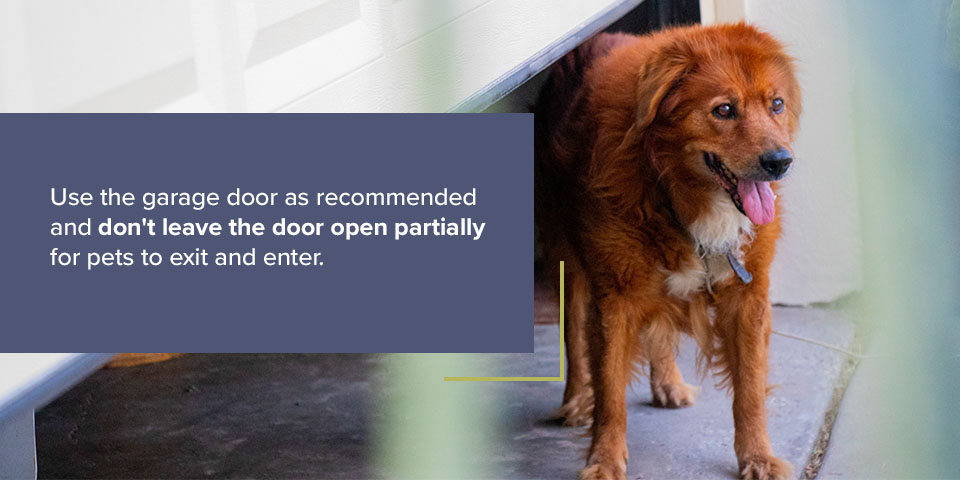
Garage Door Safety Tips for Pet Owners
Safe handling is important when you have pets. Below are some more tips for garage door safety:
1. Use the Garage Door as Recommended
Don’t leave the door open partially for pets to exit and enter. Most garage doors have a spring opening system to prevent them from slamming down when closing. When you leave them slightly open, you’re forcing the springs to work harder, and with time, they will weaken.
Once the springs wear out, the garage door can quickly slam down. You can Install a pet door on your garage door to allow cats and dogs easy access to the home without putting them in danger.
2. Check the Top of the Door Before Closing
If you have a cat that likes to climb, check the door gears before opening or closing the doors. A cat might try to climb up onto the shelf that a raised door provides to escape predators or get a good view of its surroundings. There’s a high risk of your cat getting crushed when you command your door to close, so always check the top of your garage door beforehand.
3. Invest in Routine Garage Door Maintenance
Schedule regular maintenance for your garage door to know when you should make repairs. You can ensure the door works properly and reduce the chances of it slamming down. Maintenance confirms the door’s safety features are working properly, too. For instance, you can check if your door’s reverse mechanism works by placing some cloths across the garage’s threshold. When you close the garage door, it should sense the cloth and automatically reverse. If it doesn’t reverse, call a garage door service provider to identify and solve the problem.
4. Don’t Tie Your Pet to the Garage Door
If you have to leash your pet in the garage, avoid tying them to the garage door. The metal might seem like it would be sturdy enough to support a rambunctious pet, but the mechanisms are intended only for raising the door.
5. Don’t Race a Closing Garage Door
Play games like catch, keep-away and fetch outside of the garage. Using your door for a race game or as an obstacle to get to their toy will encourage the pet to charge the door without reserve. Even if your garage door has built-in motion sensors that tell it to stop when you or your pet are in the way, it is still dangerous. In case the sensor malfunctions, or if your pet moves too fast, the garage door will miss the signal and shut anyway.
6. Don’t Let Your Pet Chew on the Door Cables
Make sure any cables or wires are safe from your pet chewing on them. If you have a pet that likes to chew, provide them with enough toys so they have a few distractions from the door. You can try blocking off the wiring, but remember to make it accessible for maintenance and repairs. You can also leave the pet crated or block their access to the garage whenever you’re away from home to keep them safe.
7. Train Your Pet
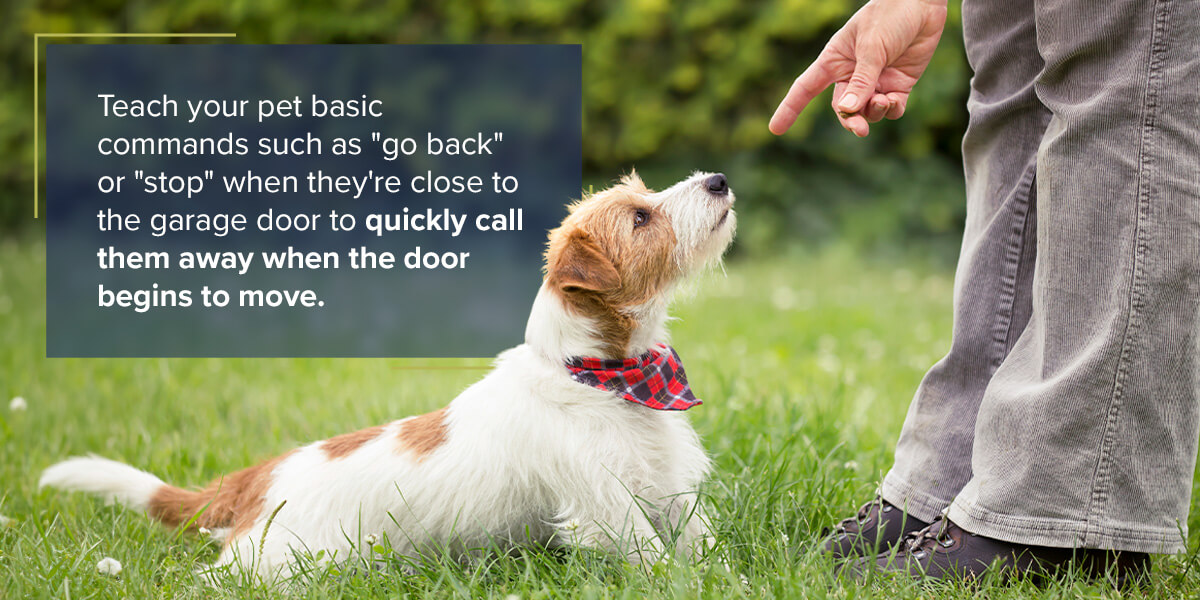
Teach your pet basic commands such as “go back” or “stop” when they’re close to the garage door to quickly call them away when the door begins to move.
8. Invest in a Quality Garage Door
The surest way to keep your pets safe is to install a garage door and opener made by reputable manufacturers. A good-quality garage door system will save you money in the long run when it comes to maintenance. Moreover, newer doors have safety features that you can trust and rely on for a long time.
9. Test Motion Detectors for Pet Safety
All automatic garage door systems have motion detectors set at ground level. Test yours to make sure they’re working properly before you allow any pets into your garage. You might have tried raising your foot over the sensor as you exited to avoid triggering the safety feature. Since animals rarely jump over the garage threshold, the sensors will detect their feet crossing over.
When one or both sensors stop working correctly, your door might stop shutting entirely, or you could have other noticeable issues. Buying a quality product will ensure that your door functions well and lasts a long time before needing repairs.
10. Install Pet Doors for Garage Safety
Rather than leaving the door raised or overusing it, which causes strain on your gears, install a pet door for convenience and safety. Pets can enter and exit the garage as they wish, and you can use your automatic motor sparingly. If you decide to get a pet door, make sure to install it a reasonable distance from the garage door to keep them away.
Buy a Quality Garage Door With Crawford Door Sales
Want to make sure your pets stay safe? Crawford Door Sales services automatic garage doors for residences in the Twin Cities area. We offer a wide variety of garage doors that can add some curb appeal to your home while keep you and your furry friends safe. Contact us to learn more.
How to Open a Garage Door When the Power Is Out
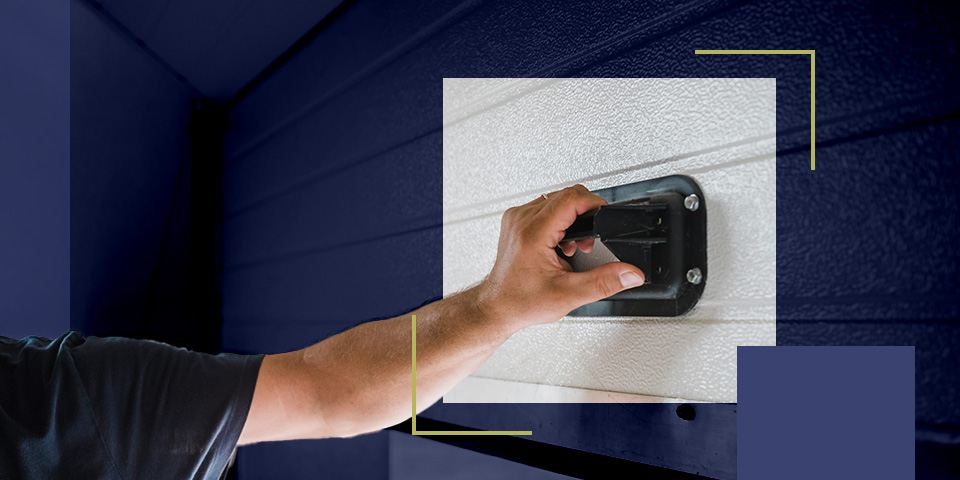
How to Open a Garage Door When the Power Is Out
Automatic garage doors offer a significant advantage — when bad weather strikes, you can avoid the outdoors and move your vehicle inside with the click of a button.
Knowing how to operate your garage door manually can help you stay comfortable, safe and secure during any emergency. The next time you have a power outage, follow these steps:
1. Inspect the Door
To work manually, your garage needs to be in good condition. Look at the door and its components — do you notice any loose springs or damages? If so, contact your local experts for repairs instead of manually operating the door.
2. Release the Trigger
Before moving forward with the next step, you must ensure the door is in the down position. Attempting to release a trigger while the door is in the open position can result in bodily harm or property damage.
Look for an emergency release cord near the front of your closed door. The cord is usually red with a T-shaped handle and hangs from your door’s track. Slowly release the trigger to disconnect the trolley from the carriage.
3. Manually Raise the Door
Use the internal handle to lift the door. You can use pressure to push the bottom edge of your door up and guide it into place as needed.
You may have a broken spring if you can’t move the door. In this case, you will need repair services.
4. Lower Your Door for Security
After you enter or exit your garage, you should lower the door. Engage the manual lock to prevent unwanted visitors from entering your property.
5. Reconnect the Opener
You will need to unlock the manual lock when your power returns. Then reattach your door to the opener using either of these methods:
- Adjust the trigger: Grab the rope and pull it toward the door until you hear a click. Visually confirm it’s locked back in before you run the opener through a complete cycle, all the way up and down.
- Engage the garage door opener: Hit the electric garage door opener’s switch to push the springs back into place. Reconnect the carriage and trolley to electrically open and close your door again.
Feel Prepared for Any Power Outage With the Best Garage Door Upgrades
Do you currently have a manual-release garage door or want to upgrade your existing overhead door? Explore the stylish and high-performance options available at Crawford Door Sales when you contact our team today!
How To Prepare Your Garage for the Winter
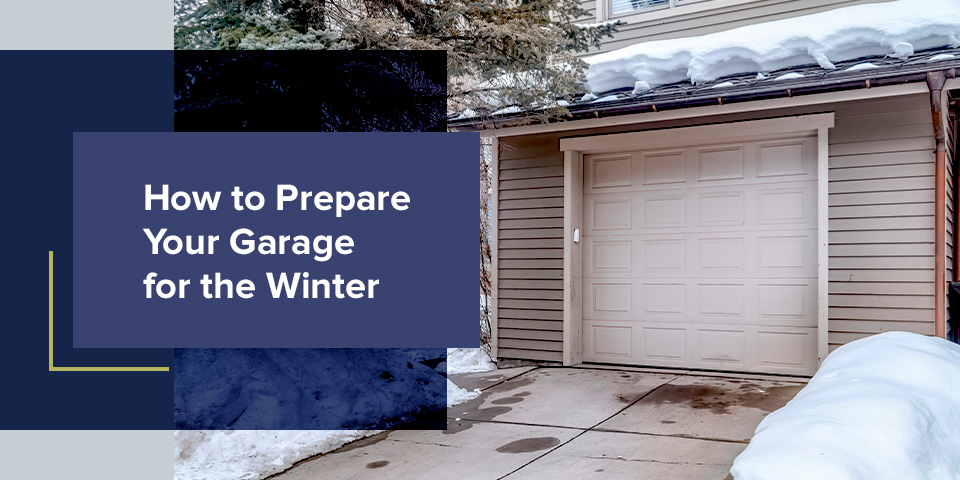
How to Prepare Your Garage for the Winter
When you’re gearing up for the colder months ahead, you want to do everything you can to prepare your home for the cold and harsh elements. Part of this is making sure your garage is also well-equipped. Your garage is an extension of your home and protects your vehicle and other belongings, so it should receive the same time and attention.
Here are a few tips on how to prepare your garage so it’s ready for winter.
Declutter and Organize
We tend to use our garage for much more than parking a car or two. The garage seems the viable and safest option when the house has no space to keep your precious summer sports gear and other valuable items. Furniture, refrigerators and other household equipment often find their way to a semi-permanent home inside the garage.
In winter, you can anticipate temperature drops that could reach a freezing point. Set time aside in the warmer months to declutter and organize things to avoid any items being damaged by the moisture and cold air in your garage. Sift through smaller items and box up anything that has monetary or sentimental value. Everything else should ideally be gifted or thrown away to save space.
Weatherproof Storage Items
If you have large equipment like furniture or a washing machine, weatherproof it by wrapping it in plastic for extra protection and let it stand on raised platforms. This is a preventative measure — if you should experience flooding in your garage, it will be safe from water damage.
Assign a dedicated spot to hang up wet shoes and clothes before entering your home so it’s not riddled with mud and dirt. Once everything is neatly stored and you’ve dusted and decluttered your garage, sweep and mop the floor for that added touch of cleanliness. Knowing you will be able to find whatever you need with ease should give you peace of mind.
Remove Chemicals and Hazardous Materials
If you’re storing chemicals in your garage, now might be the time to get rid of them. When temperatures fluctuate, the liquid content contracts and expands and may lead to chemical spillage. This is dangerous and should be avoided at all costs.
If you need to store chemicals and other parts like batteries, ensure they are secured, kept out of reach and protected from freezing.
Insulate Your Garage
If your garage isn’t already well-insulated, it could help to do it in advance. Insulating your garage has its advantages, such as:
- Heat retention: Heat and cold transmissions are reduced with insulation since it keeps the heat in and cold out as required.
- Energy conservation: Your energy bill is reduced when you insulate your garage because your HVAC system is less strained to accommodate heating the garage.
- Water heater blanket: By insulating your older water heater with a blanket, you’ll save further costs on energy bills.
- Protect stored items: Your garage is protected from humidity and dampness that can damage your items.
- Noise reduction: An insulated garage reduces noise transmission so you hear less noise pollution from the outside and keep any noise within your garage from leaking out.
Protect the Pipework
When insulating your garage, include the pipework to minimize any potential damage caused by freezing. Fluctuations in temperature and extreme cold could burst the pipes, flooding your garage. This destruction can be costly and is easily avoidable.
By keeping your pipes insulated it will also retain heat and in turn, help save energy.
Invest in Adequate Heating
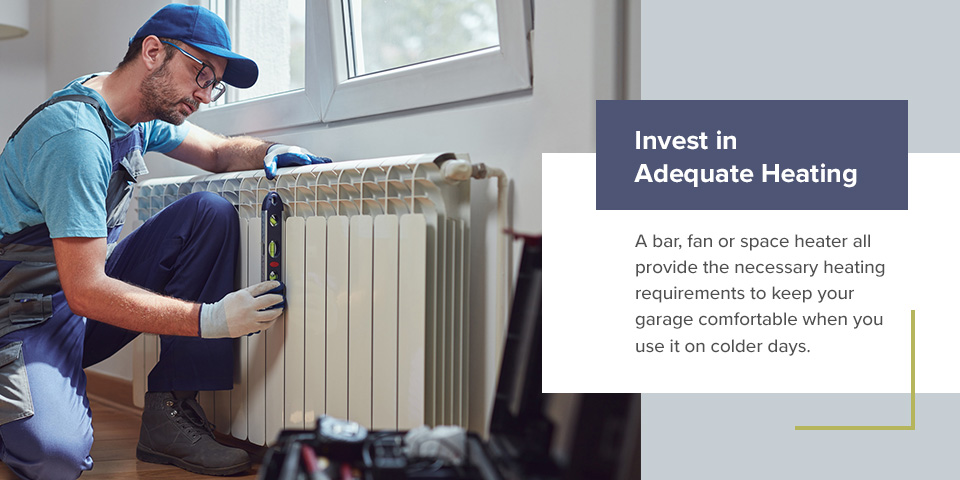
If your garage is used as a workshop, gym or office unit, you probably use it more often. In this case, you’d want the temperature to be consistent and warmer during the winter. A bar, fan or space heater all provide the necessary heating requirements to keep your garage comfortable when you use it on colder days.
Any pipework is kept at ambient temperature when you use a heater, preventing potential freezing and corrosion.
Seal Cracks and Fix Leaks
Wherever there are cracks in your garage wall, flooring, window frames and garage door, you’ll find drafts can easily enter and make the space inside cold and unpleasant. The increasingly cold and damp air could eventually also damage your stored equipment.
Inspect each section from the floor to the ceiling and walls for cracks and seal them if they’re small enough, including the exterior walls where cracks could be evident. Adding caulk around your windowpanes should help keep it sealed for winter.
If you notice any leaks, find the source and try to fix it or call a plumber to inspect the area in case there’s extensive damage you can’t see or fix yourself.
Seal the Floor
Besides sealing cracks in and around your garage, you will benefit from sealing the floor to prevent corrosion due to salt residue. This salt is used to combat slush from snow and ice and aids in keeping cars on the road. It is brought into your garage by your car and seeps into the floor, causing gradual corrosion of the top layer.
By sealing your garage floor, the surface is more resistant to any form of damage and maintains its durability.
You also decrease the chances of anyone falling and hurting themselves. An epoxy sealant that prevents slipping is especially beneficial for the winter when there’s a higher risk.
Inspect Garage Door Parts
Your garage door is the main component that protects your belongings from the direct impact of rain, sun, snow and other weather elements. Perform a thorough inspection to ensure your door is fully functional and ready for the winter. There could be negative consequences associated with neglecting to maintain your garage door, such as the risk of personal injury or damage to your vehicle.
To help protect and prepare your garage door, perform essential maintenance:
- Weatherstrip the garage door: Weatherstripping provides better protection from the cold and prevents snow and debris from entering your garage. If it is old and worn, be sure to replace it before winter hits.
- Lubricate moving parts: Lubricate any moving parts, like the track and rollers, to ensure your garage door performs optimally despite the low temperatures.
- Repair or replace worn parts: Have a garage door technician inspect your door for any worn parts. To keep you and your family safe, be sure to leave any significant repairs to the professionals.
- Check the opener: Check the opener to ensure a proper connection to the remote and other moving parts.
You can contact a professional garage door company for help inspecting your garage door and making sure it’s ready for the upcoming winter season.
Contact Crawford Door Sales for Your Garage Door Repairs and Installations
At Crawford Door Sales, we are proud to deliver superior service and workmanship on every job we do, big or small. We put you first as our valued customer and ensure every encounter is pleasant, from consultations to repairs and installations.
We look forward to helping you prepare your garage door for the winter so you can rest assured knowing your valuables are protected. Call us at (651) 455-1221 or submit a service request and we’ll take it from there.
How to Secure Your Garage Before Going on Vacation
How to Secure Your Garage Before Going on Vacation
If you’re looking forward to some well-deserved rest and relaxation on your next vacation, increase your peace of mind by taking the time to protect your garage and reduce the chance of a break-in while you’re away. A few preventive steps before vacation can help you avoid stress when you return.
Keep your garage and the rest of your home safe from burglars and theft by adding garage security to your pre-vacation checklist. Here’s what you can do to protect your garage before you leave.
1. Turn on the Vacation Lock Feature
If you have a newer garage door opener, it may be equipped with a vacation lock feature. If that’s the case, activate the feature right before you leave. Once turned on, the vacation lock prevents radio signals from opening the door until you deactivate the feature.
2. Unplug the Garage Door Opener
Older garage door openers may not have a vacation feature. If that’s the case with yours, unplug the opener before you leave. When there’s no power to the garage door opener, no one will be able to open it with a code or remote control.
3. Install an Additional Lock
You can also protect your property and belongings by adding another lock to your garage door. You can use the additional lock along with or instead of using vacation mode or unplugging the automatic garage door opener.
The extra lock attaches to the door from the inside and physically prevents someone from forcing the door open. Think of it as a heavy-duty deadbolt for your garage door.
4. Protect the Windows
If there are windows in your garage, burglars can gain entry through them. Secure the windows by installing bars on the exterior. If you don’t like the look of security bars, another option is to place window film on the interior glass. The film will make it more difficult for a burglar to shatter the glass and gain entry.
Also, consider installing blinds or curtains on the windows, so people can’t peek inside your garage while you’re away from home.
5. Install Motion-Activated Lights
Prevent aspiring burglars from accessing your belongings by installing motion-sensing exterior lights. The lights will turn on automatically whenever they detect movement, deterring would-be thieves.
6. Keep Your Vacation Under Wraps
Prevent your home from being a target for burglars by not advertising that you’re away. You can accomplish this goal by asking the post office to hold your mail and pausing newspaper or other regular deliveries. You can also connect a few interior lights to timers so that they switch on and off at night.
If you use social media, wait until you’ve returned home to share pictures and details about your time away.
Contact Crawford Door Sales Before Your Next Vacation
Before you head off to relax, make sure your garage door is in good working order. Schedule garage door maintenance or repair with Crawford Door Sales and rest easy knowing that your home will be secure while you’re away, as we specialize in garage doors. Contact us today to request service.
5 Warning Signs It’s Time for a New Garage Door
5 Warning Signs It’s Time For A New Garage Door
If you’re like many homeowners, you may not give much thought to your garage. It’s a place to put your car and store a few items you don’t want, need or have room for inside your house.
However, whether it’s an attached or a stand-alone structure, your garage can begin to show signs of age. An older garage can start to deteriorate, which may require a complete replacement. The door is one area that demands attention to ensure it’s functioning correctly and safely.
Leading Indicators of a Garage Door Replacement
Some symptoms pointing to a garage door upgrade or total structure replacement include:
1. Obvious Signs of Damage
Sometimes, it’s easy to tell when it’s time for a garage replacement. Do you see cracks in the walls or floor? These issues can indicate that the garage’s structural integrity is weakening, eventually creating a dangerous situation. Signs of animal or insect infestations also mean that these critters are finding ways to get inside.
2. Exposure to the Elements
Do you feel drafts in the garage with the door closed? Is rain, snow or wind able to get inside? These situations can be especially bothersome if you use the garage for purposes other than storage, such as a home office or gym. If the elements enter through your garage door, replacing it may help you maintain the space’s comfort.
3. Frequent Repairs
If you’re always fixing something in or around the garage, those repairs could cost a fortune in repair bills. Weighing the costs of frequent service against that of a replacement is common when deciding whether a new garage door is necessary. Investing in a new one can be a significant investment, but it can also help you save money long-term.
4. Loud Door Noises
If you hear abnormal sounds like grinding, squeaking or groaning, it likely indicates a severe mechanical issue requiring immediate attention. A sudden, loud bang usually means a snapped spring, creating a potentially dangerous situation.
5. Sagging Door
A door that sags, looks uneven or becomes unbalanced is another cause for concern. Practice caution and call a professional immediately, as these signs often mean the door is ready to fall.
Crawford Door Sales Offers Garage Door Services in the Twin Cities
If you live in the Twin Cities area and experience problems with your garage door, the experts at Crawford Door Sales can meet all your replacement and repair needs. Contact us to request additional information or schedule a convenient service appointment today.
Anatomy of a Garage Door Explained
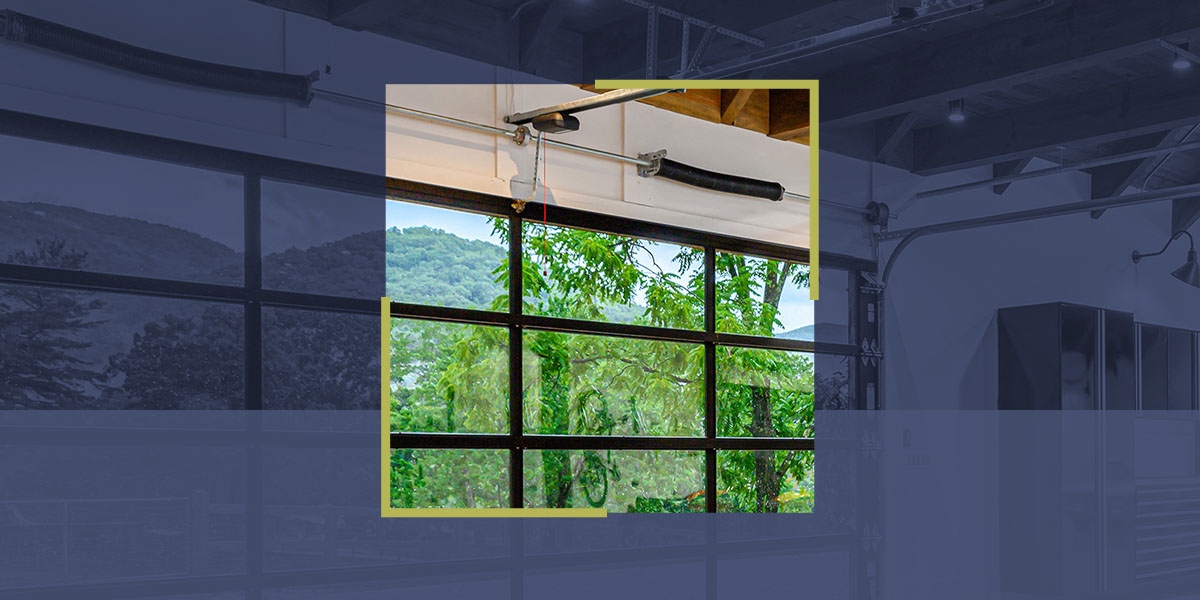
Your garage door is an essential element in your day-to-day life. A garage door plays many roles, whether you rely on it to exit or enter your home, protect your equipment or safeguard your home or business from intruders.
Although the door function may appear seamless, many components work hard to allow entrances and exits. Each element is vital to the door’s movement, and understanding how they work can ensure your door stays in the best shape. Learn what the parts of a garage door are called and how they work to lift and lower your door.
How Does a Garage Door System Work?
Your garage functions when all the components in the system work together. When it’s time for the door to raise or lower, you can do so with the push of a button. When the motor runs, the other parts of a garage structure respond. The door will slide open by moving over rollers along a track to reach the ceiling. Additional components counter the door’s weight, allowing it to move up and down seamlessly.
What Are the Parts of a Garage Door?
Understanding your garage door parts can be helpful when you need to make repairs, require new door installation or want to consider customization options. The better you know the parts, the more easily you can determine the best solution for your door and space. Here are the essential garage door components to understand:
Garage Door Opener
Your opener is a vital component of your system. Without this piece, your door would not receive instructions to open or close. One of the most important parts of a garage door opener system is the sensor that triggers when it’s time to respond. This sensor often has a distance sensitivity, so you can rest assured that you won’t accidentally open the door from the remote while away.
Tracks and Rollers
The rollers and tracks allow your door to slide up and down. Rollers will often have a metal rod and wheel made of steel or nylon. Rollers glide on the tracks fit along the door sides.
The tracks run vertically on either side of the door and above it along the ceiling. The tracks guide the door where it needs to go while it moves along the rollers to open or close. Most doors have a safety feature to prevent the door from opening if it comes off the track to avoid damage and injuries.
Springs
Although the motor signals when to open or close the door, the springs produce the energy the system needs to lift or lower the door. Depending on the age and model of your door, it has torsion or extension springs. Most modern doors will have torsion springs above the door, but older homes and businesses may have extension springs on the horizontal track.
These springs harness potential energy that controls the door’s movement and prevents it from slamming shut or snapping open. If you experience either of these issues, call a professional for immediate assistance, as garage door springs can injure people or cause damage if they fly free.
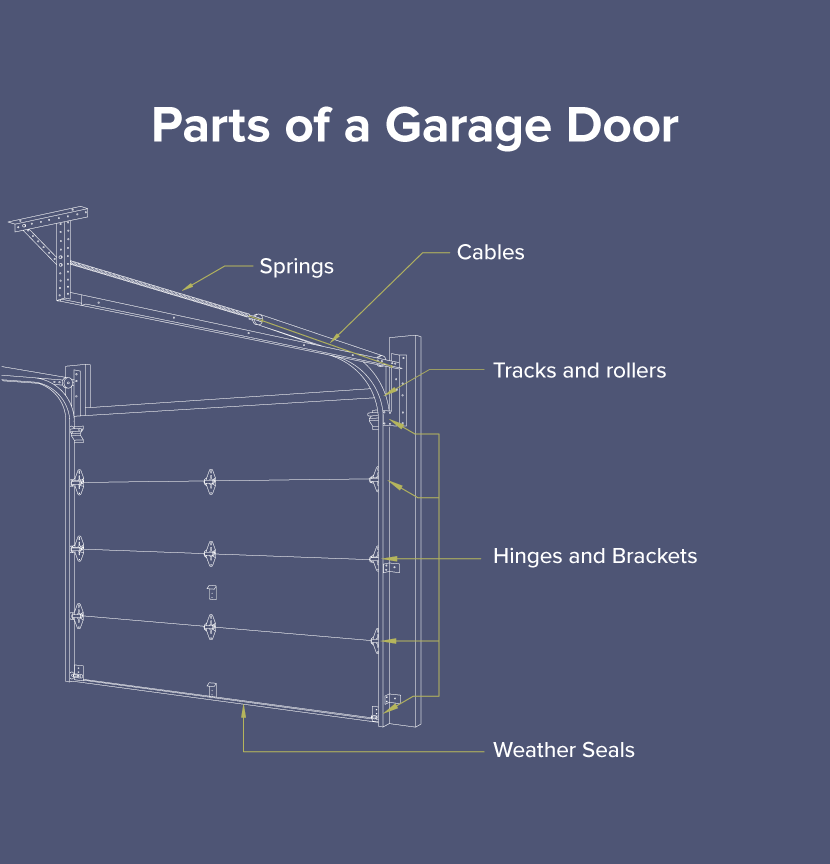
Hinges and Brackets
These metal pieces hold other components in place and connect sections of your door together. Hinges are in the middle of the door to attach the panels and bend as the door opens or closes. Brackets typically keep rollers and cables fastened on the door sides.
Panels
Panels act as a protective layer and a stylish choice. Panels come in various styles and face the outdoors. Typically, you can choose between wood, aluminum, steel, vinyl or fiberglass panels to achieve your preferred look. These can boost curb appeal for a home or business and protect the rest of your garage door components from the elements.
Cables
Metal lifting cables on either side of the door connect the door and the opening mechanism. Each garage door cable attaches to the bottom of the door and stretches to the top of the door to reach the drum. As the drum rotates, the cable rolls up, lifting the door.
Drums
The drums connect to the cables, lifting and lowering your door when needed. They also connect to the tube shaft and act as pulley wheels. The drums rotate when the springs release energy. In turn, this will cause the cables to move.
Tube Shaft
The tube shaft runs across the top of the door and holds the springs in place. It remains stationary and ensures the springs can function properly, allowing the cables and drums to react to their energy.
Weather Seals
For additional protection, your door will have a weather seal to protect the door and items inside the garage from natural elements. The weather seal runs along the door bottom, preventing drafts, rain, snow, insects and debris from entering. This helps increase the door’s energy efficiency and can extend the life span of other door components by protecting them from weather conditions and pests that could damage them.
Emergency Cord
The emergency cord is a safety feature that can disengage the door from the opener. This cord hangs on the inside of the door and disconnects the door from the motor when pulled. It typically has a red tag to indicate the safety feature and ensure no one pulls it accidentally.
Although the motor is disengaged, the springs still function, allowing you manually open the door. This feature is excellent when you want to perform maintenance without the risk of accidental opening or closing. For example, a homeowner who needs to open the door halfway could use the emergency cord to prevent someone else from opening the door with a remote while they work.
Safety Sensor
Another safety feature on your door is the safety sensor. Similar to the emergency cord, these photo eye sensors can stop the door from moving. The photo eye has two sensors, which you can locate on either side of the door near the floor. One sensor projects a beam to the other across the door. If an object or person is underneath your door, the beam will break, signaling to the door that it is unsafe to lower.
Count on Crawford Door Sales for Your Garage Needs
Crawford Door Sales is family-owned and operated. We’ve had the pleasure of serving commercial and residential garage door owners for more than 60 years. Our vast experience has empowered us to offer superior service and products to anyone needing to keep their door in tip-top shape or replace an existing system.
Our goal is to provide the best professional installation, deliver high-quality service and offer the best products available to each customer. We can help you learn more about garage doors or repair or replace an existing one. Call us or fill out our contact form, and let us be your one-stop shop for all your garage door needs.
How to Inspect Your Garage Door
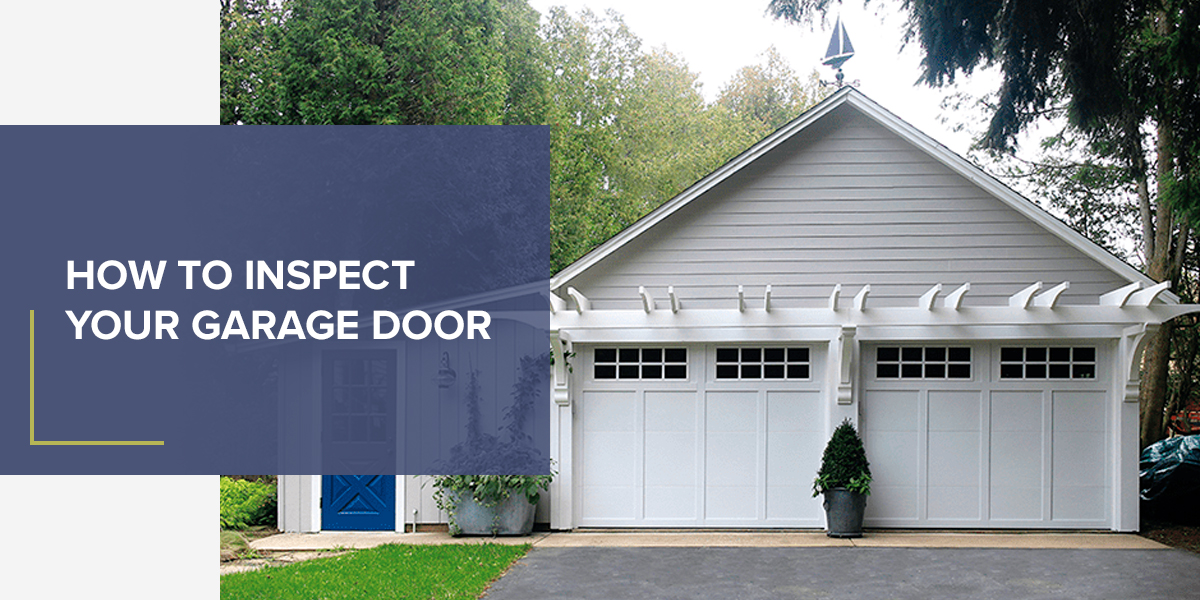
If you’re like many homeowners, you and your family may open and close your garage door several times a day. All this wear and tear can take a toll on your door and its various operating mechanisms.
Like any mechanical object, a garage door needs regular service to keep it in peak working condition and safe to operate. You can do your part by periodically checking the door to spot potential repair issues before they become significant problems.
How to Inspect a Garage Door
At Crawford Door Sales, we’ve been providing expert garage door services in Minnesota’s Twin Cities region since 1958. Use our comprehensive garage door inspection checklist to assess the areas most likely require attention.
1. Photo Eye Sensors
These small devices are affixed to either side of the door’s opening about 6 inches above the ground. Their purpose is to stop the door from closing and cause it to reverse direction if it encounters an object.
To test the sensors, place a block of wood or another object that is more than 6 inches tall in the opening and begin the closing process. If the door doesn’t close, the sensors are functioning correctly.
2. Tracks and Rollers
These mechanisms enable the door to move freely and keep it open when you want it to remain that way. Inspect them by switching the opener into manual mode and moving the door into various positions by hand. The door should stay on track as you make these adjustments.
You should also check the rollers for signs of corrosion, cracks, chips or warping.
3. Springs
Springs are essential for raising and lowering the door and counterbalancing its weight. If the springs squeak during operation, apply a lithium grease or silicone spray to lubricate them. If you notice rust or other signs of damage, call a professional garage door technician to address the issue.
Spring repair is not a do-it-yourself project. The built-up tension in the springs can cause them to snap, which can lead to severe injuries.
4. Pulleys and Cables
Garage door systems have a series of pulleys and cables that lift the door and move it along the belt. Check them to ensure they move freely during operation and that the cables aren’t beginning to fray.
5. Weatherstripping
The rubber treads on the bottom and sides of your door provide a seal that makes the garage more energy efficient. Check the weatherstripping for obvious signs of wear and replace it if necessary.
How Do You Inspect a Garage Door Opener?
You should also know how to test a garage door opener to ensure your door will operate safely and efficiently. All openers manufactured after January 1, 1993, have a built-in auto-reverse mechanism that functions much like the photo eye sensors.
To test this feature, place a block of wood or another object at least 1.5 inches high at the door’s edge. Press the opener’s button to close the door. If the auto-reverse is working correctly, the door will stop and change direction.
Contact Crawford Door Sales for Additional Assistance
Crawford Door Sales can perform a fast, professional garage door inspection to ensure your door is functioning correctly. We can also handle any maintenance or repair issues we discover during our check. Contact us to schedule a convenient appointment today.


